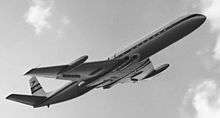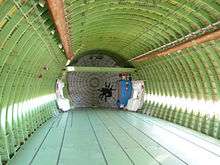Airframe

The airframe of an aircraft is its mechanical structure. It is typically considered to include fuselage, wings and undercarriage and exclude the propulsion system. Airframe design is a field of aerospace engineering that combines aerodynamics, materials technology and manufacturing methods to achieve balances of performance, reliability and cost.[1]
History
.png)
Modern airframe history began in the United States when a 1903 wood biplane made by Orville and Wilbur Wright showed the potential of fixed-wing designs. Many early developments were spurred by military needs during World War I. Well known aircraft from that era include the Dutch designer Anthony Fokker's combat aircraft for the German Empire's Luftstreitkräfte, and U.S. Curtiss flying boats and the German/Austrian Taube monoplanes. These used hybrid wood and metal structures. During the war, German engineer Hugo Junkers pioneered practical all-metal airframes as early as late 1915 with the Junkers J 1 and developed further with lighter weight duralumin in the airframe of the Junkers D.I of 1918, whose techniques were adopted almost unchanged after the war by both American engineer William Bushnell Stout and Soviet aerospace engineer Andrei Tupolev. Commercial airframe development during the 1920s and 1930s focused on monoplane designs using radial piston engines. Many, such as the Ryan model flown across the Atlantic by Charles Lindbergh in 1927, were produced as single copies or in small quantity. William Stout's designs for the all-metal Ford 4-AT and 5-AT trimotors,[2] Andrei Tupolev's designs in Joseph Stalin's Soviet Union for a series of all-metal aircraft of steadily increasing size, culminating in the enormous, eight-engined Maksim Gorky (the largest aircraft of its era), and with Donald Douglas' firm's development of the iconic Douglas DC-3 twin-engined airliner,[3] were among the most successful designs to emerge from the era through the use of all-metal airframes. The original Junkers corrugated duralumin-covered airframe philosophy culminated in the 1932-origin Junkers Ju 52 trimotor airliner, used throughout World War II by the Nazi German Luftwaffe for transport and paratroop needs.
During World War II, military needs again dominated airframe designs. Among the best known were the US Douglas C-47, Boeing B-17, North American B-25 and Lockheed P-38, and British Vickers Wellington that used a geodesic construction method, and Avro Lancaster, all revamps of original designs from the 1930s. The wooden composite construction high performance fighter-bomber de Havilland Mosquito was developed during the war. The first jets were produced during the war but not made in large quantity. The Boeing B-29 was designed to be a high altitude bomber, the first with a pressurised fuselage.
Postwar commercial airframe design focused on larger capacities, on turboprop engines, and then on jet (turbojet, later turbofan) engines. The generally higher speeds and stresses of turboprops and jets were major challenges.[4] Newly developed aluminum alloys with copper, magnesium and zinc were critical to these designs.[5] The Lockheed L-188 turboprop, first flown in 1957, used some of these materials and became a costly lesson in controlling vibration and planning around metal fatigue.

The de Havilland Comet was the world's first commercial jet airliner to reach production. It first flew in 1949 and was considered a landmark in British aeronautical design. After introduction into commercial service, early Comet models suffered from catastrophic airframe metal fatigue, causing a string of well-publicised accidents. The Royal Aircraft Establishment investigation at Farnborough, founded the science of aircraft crash reconstruction. Over 3000 cycles of pressurisation later, in a specially constructed pressure chamber, airframe failure was found to be due to stress concentration, a consequence of the square shaped windows. The windows had been engineered to be glued and riveted, but had been punch riveted only. Unlike drill riveting, the imperfect nature of the hole created by punch riveting may cause the start of fatigue cracks around the rivet.
Eventually Boeing in the U.S. and Airbus in Europe became the dominant assemblers of large airframes, known as wide-body aircraft. Numerous manufacturers in Europe, North America and South America took over markets for airframes designed to carry 100 or fewer passengers. Many manufacturers produce airframe components.
Present and future

Four major eras in commercial airframe production stand out: all-aluminum structures beginning in the 1920s and directly inspired by Hugo Junkers all-metal designs from as far back as 1915, high-strength alloys and high-speed airfoils beginning in the 1940s, long-range designs and improved efficiencies beginning in the 1960s, and composite material construction beginning in the 1980s, partly pioneered by Burt Rutan's designs. In the latest era, Boeing has claimed a lead, designing its new 787 jetliner with a one-piece carbon-fiber fuselage, said to replace "1,200 sheets of aluminum and 40,000 rivets."[6] The Airbus A380 is also built with a large proportion of composite material. Cirrus Aircraft's SR20 design, certified in 1998, was the first general aviation aircraft manufactured with all-composite construction, followed by several other light aircraft in the 2000s.[7]
Airframe production has become an exacting process. Manufacturers operate under strict quality control and government regulations. Departures from established standards become objects of major concern.[8] The crash on takeoff of an Airbus A300 in 2001, after its tail assembly broke away from the fuselage, called attention to operation, maintenance and design issues involving composite materials that are used in many recent airframes.[9][10][11] The A300 had experienced other structural problems but none of this magnitude. The incident bears comparison with the 1959 Lockheed L-188 crash in showing difficulties that the airframe industry and its airline customers can experience when adopting new technology.
See also
Notes and references
- ↑ Michael C. Y. Niu (1988). Airframe Structural Design. Conmilit Press LTD.
- ↑ David A. Weiss (1996). The Saga of the Tin Goose. Cumberland Enterprises.
- ↑ Peter M. Bowers (1986). The DC-3: 50 Years of Legendary Flight. Tab Books.
- ↑ Charles D. Bright (1978). The Jet Makers: the Aerospace Industry from 1945 to 1972. Regents Press of Kansas.
- ↑ Key to Metals Database (2005). Aircraft and Aerospace Applications. INI International.
- ↑ Leslie Wayne (May 7, 2006). "Boeing Bets the House on Its 787 Dreamliner". New York Times.
- ↑ "Top 100 Airplanes:Platinum Edition". Flying. Retrieved 2015-02-19.
- ↑ Florence Graves and Sara K. Goo (Apr 17, 2006). "Boeing Parts and Rules Bent, Whistle-Blowers Say". Washington Post. Retrieved April 23, 2010. U.S. "whistleblower" lawsuit.
- ↑ Todd Curtis (2002). "Investigation of the Crash of American Airlines Flight 587". AirSafe.com.
- ↑ James H. Williams, Jr. (2002). "Flight 587". Massachusetts Institute of Technology.
- ↑ Sara Kehaulani Goo (Oct 27, 2004). "NTSB Cites Pilot Error in 2001 N.Y. Crash". Washington Post. Retrieved April 23, 2010.